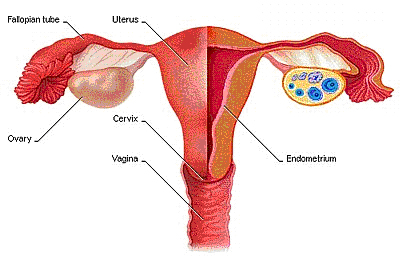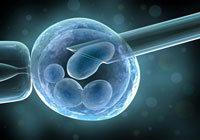Your reproductive organs are comprised of a vagina, a cervix, a uterus, fallopian tubes and ovaries. All of these organs work together to help you menstruate, conceive and carry a baby to term. The uterus, located in a woman's abdomen, is a hollow, elastic reproductive organ, where a baby develops during pregnancy.

|
| |
|
|
|
|
| |
Vagina |
|
This tube like structure is the passage which connects your internal reproductive organs with your external genitalia. It ends at the cervix which is the mouth of the uterus. During intercourse the semen is deposited in the vagina. |
|
| |
|
|
|
|
| |
|
|
|
|
| |
|
|
|
|
| |
Cervix |
|
This part of your reproductive organs is situated between the vagina and uterus. The cervix is the opening that sperm must pass through in order to reach an egg. The cervix helps to store the sperms and release them periodically so as to make sperms available around the time of ovulation. Cervical mucus may also help sperm transport. |
|
| |
|
|
|
|
| |
|
|
|
|
| |
|
|
|
|
| |
Uterus |
|
The uterus or womb is a muscular organ where the fertilized egg or embryo attaches itself and develops. It is about the size and shape of a pear, and is lined with a rich and nourishing lining called the endometrium. |
|
| |
|
|
|
|
| |
|
|
|
|
| |
|
|
|
|
| |
Fallopian Tubes |
|
The fallopian tubes extend off the upper sides of the uterus and lead up to the ovaries. They have 20 to 25 finger-like structures on their ends that hover just above the ovaries and work to collect the mature egg when it is released. It is in the fallopian tubes that fertilization of the egg will take place. |
|
| |
|
|
|
|
| |
|
|
|
|
| |
|
|
|
|
| |
Ovaries |
|
Women usually have two ovaries, one on each side of the uterus. Ovaries are the storing house for your eggs or oocytes. The eggs are contained in structures called the follicles. Women are born with their full quota of eggs i.e. more than 3 million. Their number falls to 450,000 by puberty. In the entire reproductive lifespan only around 400 eggs are used. Every month, one of these egg follicles will mature and release an egg which is picked up by the fallopian tubes. The ovaries are also responsible for producing estrogen and progesterone, which are vital for proper reproductive function. |
|
| |
|
|
|
|
|
| |
|
 |
Each month during the reproductive years i.e. from puberty to menopause, the woman goes through a menstrual cycle, which on an average is a 28-day cycle. In one cycle usually only a single egg or ovum matures inside a follicle. Halfway through the cycle, the egg is released from the follicle in a process called ovulation. Once an egg has been released from the ovaries, it will begin to travel down the fallopian tubes towards the uterus. As it advances towards the uterus, it begins to attract and guide any sperm that may have been ejaculated into the female reproductive system during sex.
Although a man releases millions of sperm when he ejaculates during orgasm, only a few hundred will be able to make it all the way from the cervix up into the uterus and then into the correct fallopian tube. Just one sperm will then be able to make its way through your eggs tough coating to fertilize the egg. The fertilized egg will then continue traveling down the fallopian tube to the uterus. Once in the uterus, the egg will implant itself into the endometrial lining and officially become an embryo. Your body will also probably start letting you know that it is pregnant now.
|
The sequence of events is controlled by monthly changes in the levels of the hormones FSH & LH secreted by the pituitary gland and the hypothalamus. If fertilization does not occur the endometrial lining breaks down and is expelled outside the body as the menstrual flow or menses, which lasts for 3-4 days on an average. |
|
A woman is fertile only for a few days during each menstrual cycle. If you are trying to conceive, it is a good idea to chart and monitor changes (you can speak to one of the doctors regarding home monitoring your time of ovulation ) in your body every month. This will help you identify just when ovulation is taking place. You are most likely to become pregnant if you have sex at or near the time of ovulation. Once ovulation has occurred, there is only about a 24-hour window in which the egg can be fertilized. However, while an egg has a very limited lifespan, sperm can remain viable inside a woman anywhere from three to five days. Therefore, a woman is thought to be most fertile from several days before to one day after she has ovulated. |
 REPRODUCTION IN WOMEN
REPRODUCTION IN WOMEN





